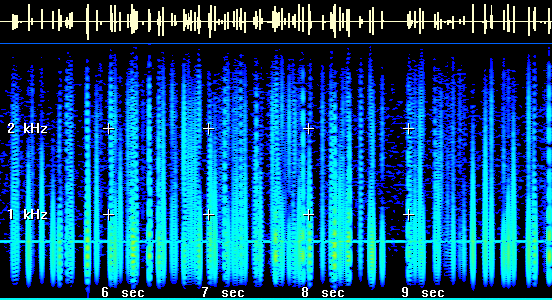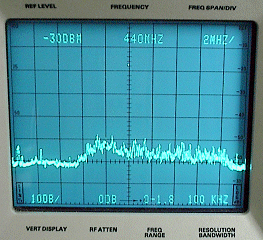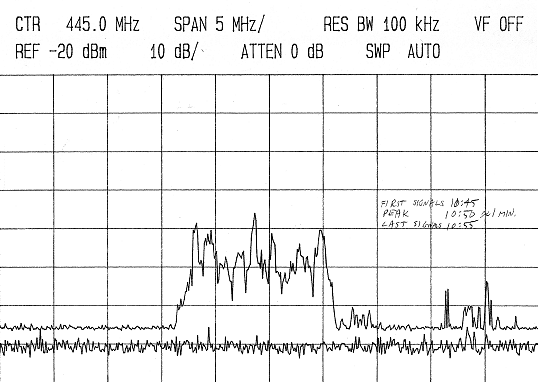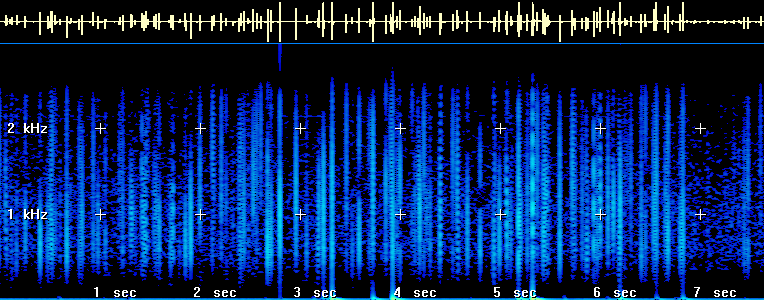
Spectrogram of the Signal - 2215 UTC October 22, 2001
Since early 2001 I've been detecting an impulse emission on the amateur 70cm band that has a spectrum approximately 12 MHz wide. This spectrum runs from 437 MHz to 449 MHz. I can detect it several times a day. It can also be heard at times simultaneously by stations hundreds of miles apart. It sounds much like ignition noise except for the individual pulses seem to be mostly at random with an occasional hint of rhythm. Given the very short pulse duration and the very broad bandwidth of the signal I reasoned that the pulse power must be pretty high or very close.
(In short, I have very good reason to believe the transmissions are from an EPLRS system. Since amateurs are secondary users to the 70cm band there isn't much that can be done about it except to be good neighbors. Hopefully this page will satisfy the curiousity of others who have been plagued with this noise on 70cm.)
I was originally concerned about the emissions thinking that they may have been unauthorized commercial communications from LEO (Low Earth Orbiting) satellites. There is always the threat of the commercial industry taking our amateur frequencies. In the United States, the 70cm amateur band is secondary to that of the military. However, no commercial users have approval to operate in this spectrum as far as I know. If it was a commercial user they could suggest at a latter date that they had already been operating within the amateur spectrum for several years with no one noticing their existence. I believe now we can rest assured that this is not the case. After a couple of years of monitoring the emissions and collaborating with others it is believed that the signals are probably from some kind of air to ground spread spectrum communications. I think most hams on 70cm have noticed their existence but simply assumed that the "noise" was something of local origin and ignored it.
Below is an example of what the signal sounds like. I recorded this signal on October 22, 2001 at 2202 UTC:
Also on October 22, 2001 I realized that I wasn't the only one hearing the emission. On 443.500 MHz the "Armadillo" group has a local repeater that is networked with other repeaters throughout much of Texas. While making some recordings of the emission a user on the repeater commented on what sounds to be the same "noise" problem. Below is a recording and detected baseband spectrogram of this event of October 22, 2001 at 2215 UTC:

Below is a spectrum of the signal that I recorded. The antenna location was poor but the spectrum of the noise is cleary visible on the display below. The half power points are approximately 437 MHz and 449 MHz. Notice how it is conveniently centered on the most active part of the amateur 70cm band! Some of the sharp spikes are normal narrowband transmissions within the band.


Keith Pugh, W5IU loaned me his Icom IC-475A so that I could record the emission using the SSB mode. It took me a while but I finally managed to get a good recording of the emission on December 27, 2002 at 1143 UTC on 438.025 MHz USB. The below recording was made with the AGC essentially disabled by cranking the RF gain back so that the AGC wasn't controlled by the signal. This allowed for the full dynamic range of the signal to be recorded. Also, using a hand held KLM 7 element yagi I tried to get a bearing on the signal. I did get a bearing to the southeast of my location. Later I detected the emission to my southwest. Soon I realized that the signal came from different directions at different times and with periods that would make it unlikely to be originating from an LEO satellite.. Take a listen for yourself and view the spectrogram of it. These is a bit of a rhythm to the emission however I still don't know for sure what it is.
